En lille hilsen fra England, hvor jeg var ude at køre på en 2 kilometer lang 914mm bane ud til South End pier – angiveligt verdens længste.
Der kom derfor ikke nyt fra mandagens mafd sidste uge fra min hånd; godt Lars var vikar ?
Dagen var desværre fuldstændig tåget, så havudsigten var stærkt begrænset. Men togturen i tågen var nu fin nok og foregik på Hallowen. Vi gik tilbage og kunne der snuppe et par fotos.
Carsten har desuden fundet dette link, som får disse ord med på vejen:
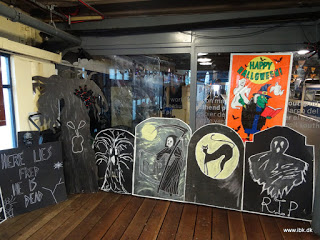 |
| Hallowen på den lille station |
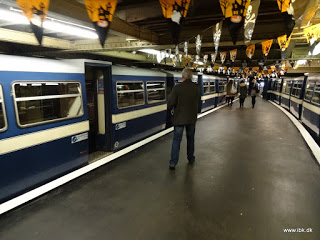 |
| to tog klar til afgang. |
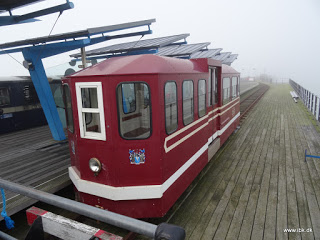 |
| Banens kongevogn |
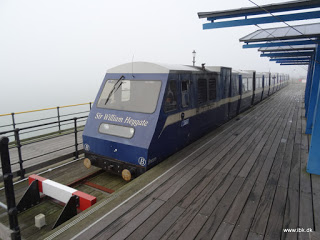 |
| Toget ankommet ude på pierens endestation |
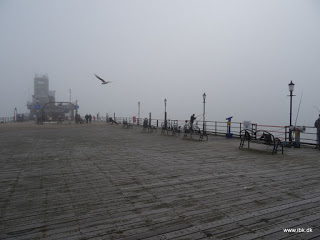 |
| “havudsigt….” Redningsstationen i baggrunden |
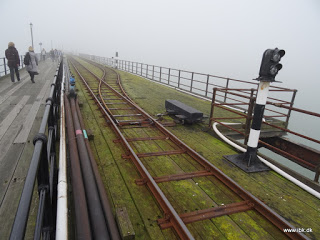 |
| midtvejsstation |
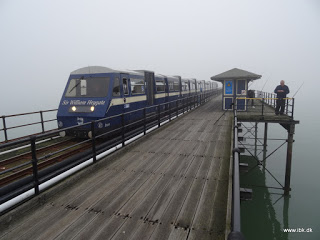 |
| Toget på vej tilbage mod land |
Lidt om banens historie fra WIKI:
The current Southend Pier was preceded by a wooden pier built in 1830. In 1851, a narrow gauge horse tramway was introduced to convey goods and visitors to the pier head.[2][3]
Construction of the current pier commenced in 1887, and the plans included provision for an electric railway. Construction of the line commenced in 1888, with electrification being carried out by Colonel R. E. B. Crompton. By 1890, 0.75 miles (1.21 km) of 3 ft 6 in (1,067 mm) gauge single track had been laid, and a single toastrack style car was in use. By the following year the line ran the then full pier length of 1.25 miles (2.01 km) and trailer cars were in use. The system expanded, until eventually, by 1930, four trains, each made up of seven cars, were running on a line that was double track throughout.[2]
In 1949 the rolling stock was replaced with new trains similar in design to London Underground stock, built by AC Cars, of Thames Ditton, in Surrey. The new stock comprised four trains, again of seven cars, and was liveried in green and cream. Each train could carry up to 260 passengers. At a top speed of 18 mph, the journey took four minutes each way, and during peak periods a train ran every five minutes, continuing until 11pm. The record for passengers carried in one day stands at 55,000.[2][4]
In 1950, two redundant 1899 built trailer cars were acquired by Volk’s Electric Railway in Brighton, where they were converted into motor cars numbered 8 and 9. These cars continued to operate in Brighton until the late 1990s, when they were again retired. Car 8 was returned to Southend to join the Southend Pier Museum collection, and car 9 is on display at the South Downs Heritage Centre at Hassocks.[5]

No.2 signalbox, crossovers and train in 1972
In 1978 the electric railway closed, due to deterioration and the cost of repairs. The 1949 built electric cars were withdrawn, although preserved examples can be found in the Southend Pier Museum and the Lynn Tait Gallery in Leigh-on-Sea.[2][6]

in burgundy and white livery in 1987 (collapsed pier section behind)
The railway was reopened by Princess Anne on 2 May 1986 after rebuilding to 3 ft (914 mm) gauge.[7] Two new diesel trains were built by Severn Lamb and introduced on a simplified line comprising a single track with a passing loop and twin track terminal stations. As originally delivered, the trains were liveried in all-over burgundy with a white waist-band, but were repainted to a two-tone blue in 2006, retaining the white waist band. They also carry a “Southend Borough Council” logo.[2]
A battery powered single passenger car, built by Castleline of Nottingham, entered service in November 1995 for service in winter. This car is numbered 1835, the year that Southend Pier first appeared on Admiralty charts.[3] There are also several wagons for maintenance trains.
On 9 October 2005, a fire severely damaged much of the pier head including the railway station. The station was temporarily re-sited, until a new and modern structure was opened on the original site in September 2009.[8][9] Although the passenger trains were not damaged, two wagons used on maintenance trains were destroyed in the fire.
Related








